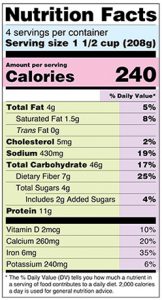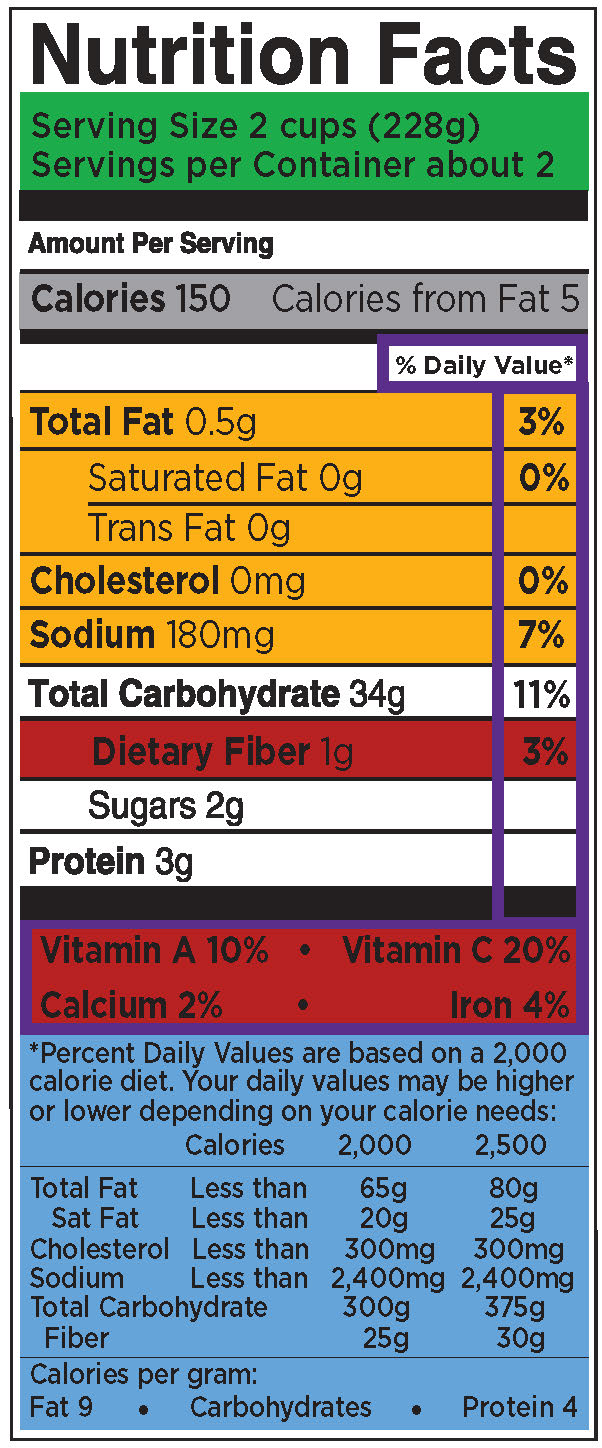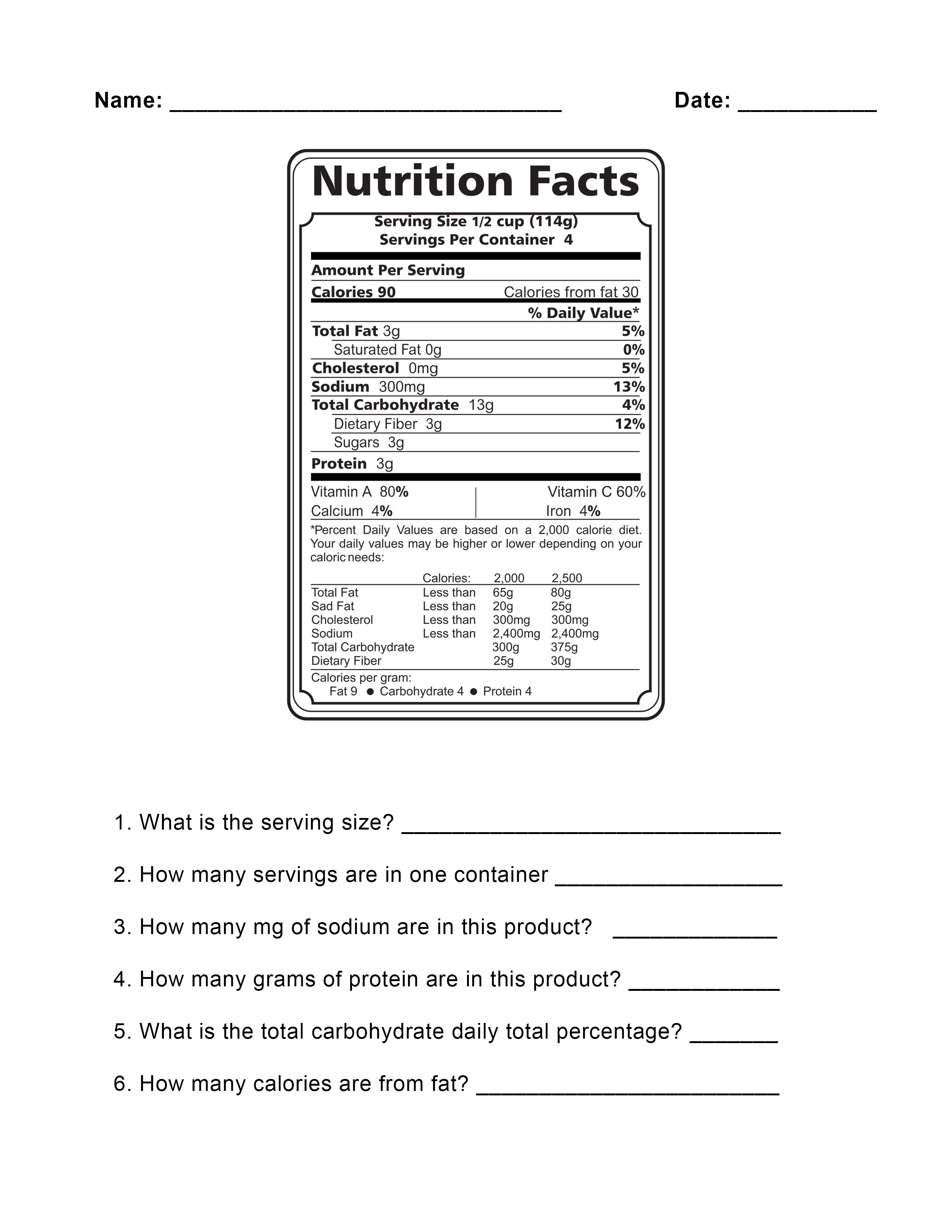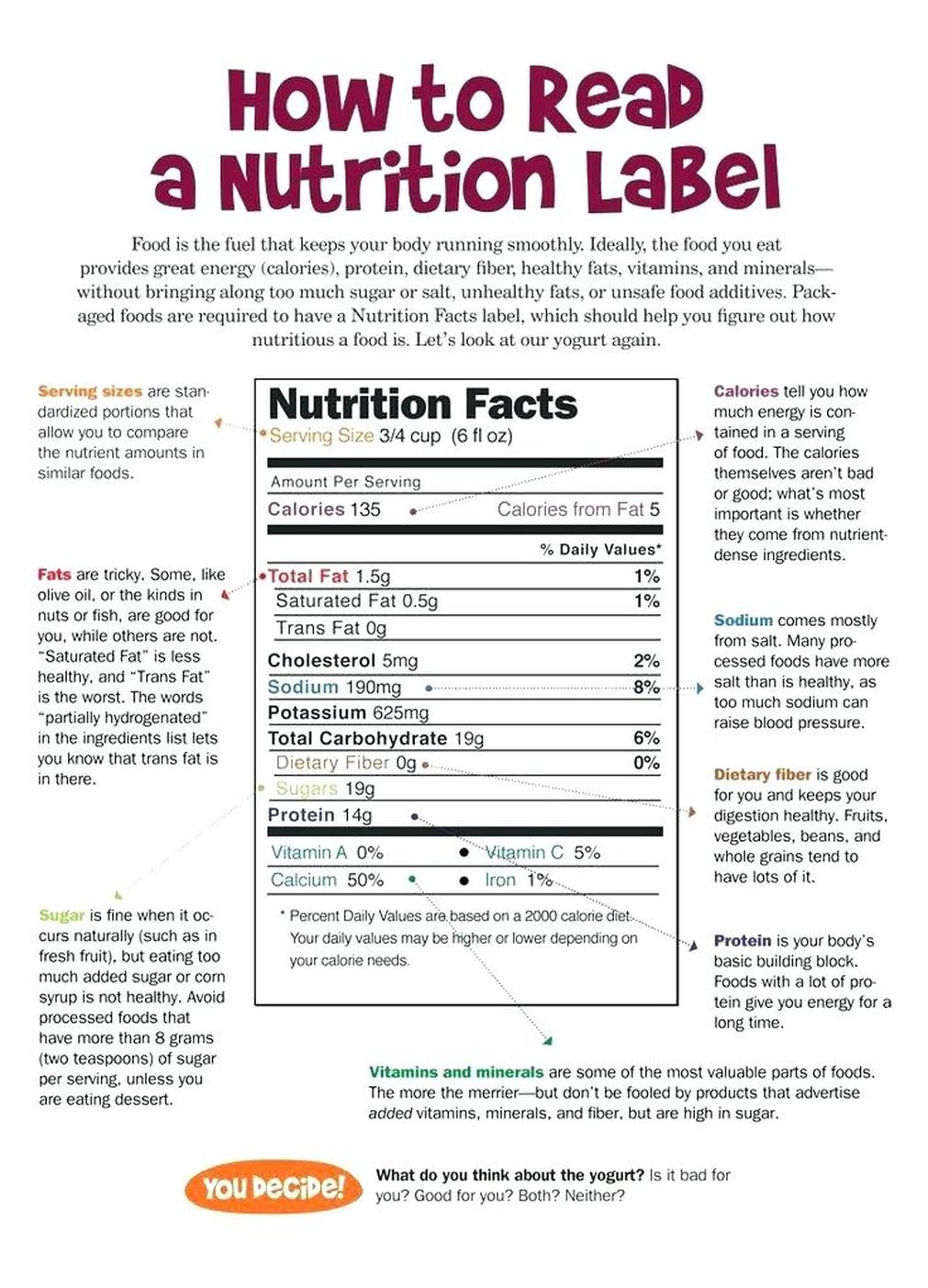41 how to read nutrition labels fat
How to Read Food Labels for a Heart-Healthy Diet The lower the net carbs, the better." Berries: "I usually choose blueberries, which are anti-inflammatory and not as high in sugar as bananas.". Yogurt: "I choose a low-fat brand that's marketed as 'diabetes friendly' on the label, which means it's low in carbohydrates. You get all the benefit of yogurt with far fewer carbs. How to understand food labels - Eat For Health The Nutrition Information Panel on a food label offers the simplest and easiest way to choose foods with less saturated fat, salt (sodium), added sugars and kilojoules, and more fibre. It can also be used to decide how large one serve of a food group choice or discretionary food would be and whether it's worth the kilojoules.
Interactive Nutrition Facts Label Fat is found in foods from both plants and animals.Total Fat on the Nutrition Facts label includes: Saturated fat is found in higher proportions in animal products and is usually solid at room temperature.; Trans fat formed naturally is found in small amounts in dairy products, beef, and lamb.Trans fat formed artificially during food processing is found in partially hydrogenated oils, which ...

How to read nutrition labels fat
Food Labels: Fat & Cholesterol | Home & Garden Information Center The Nutrition Facts label shows you how much fat is in a product, even if the fat is hidden as an ingredient. The serving size and the nutrients listed on this label are consistent, which makes it easy to compare similar products without any calculations. % Daily Values (% DVs) are listed in a column on the "Nutrition Facts" label. How To Understand And Use The Nutrition Facts Label The calories on the nutrition label are listed as "calories from fat" and "calories from carbohydrates." 3. Determine the percent daily value. The percent daily value (%DV) is the amount of a nutrient that is in one serving of the food, expressed as a percentage of the daily recommended intake. ... Here's a guide to reading the ... PDF MOVE! Nutrition Handout N10: How to Read a Nutrition Facts Label size" is the official term used on food labels. Nutrition facts given on the food label are based on one serving. Be sure to look at the number of servings in the container. Even small containers may have more than one serving. If you eat the whole container, then you must multiply the nutrition values by the number of servings in the ...
How to read nutrition labels fat. 10 tips for understanding food labels - Heart Matters magazine How to read food labels: MedlinePlus Medical Encyclopedia If a food has these fats, the amount will be listed on the label under total fat. They are measured in grams. Look for foods that have no trans fats or are low in them (1 gram or less). Sodium is the main ingredient of salt. This number is important for people who are trying to get less salt in their diet. Quick Tips for Reading the Nutrition Facts Label To create your Tip Card: 1. Use a pair of scissors to cut along the dotted lines. 2. Fold along the center line. 3. Keep the Tip Card in your wallet or purse. Calories230 Amount per serving Serving... Food Labels | CDC Check the Serving size first. All the numbers on this label are for a 2/3-cup serving. This package has 8 servings. If you eat the whole thing, you are eating 8 times the amount of calories, carbs, fat, etc., shown on the label. Total Carbohydrate shows you types of carbs in the food, including sugar and fiber.
PDF A Guide to Reading Food Labels - University of Rochester of calories from fat. You should limit the number of calories from fat to 20-35% of your total daily calories. In the sample label, there are 250 calories in one serving and 110 calories from fat. This means almost 50% of the calories in a single serving of this food come from fat. Due to its high fat content, this food is not a healthy choice. Reading and Understanding Food Labels and Nutrition Info - Beaumont Health A one-percent reduction of saturated fat in your diet reduces your heart disease risk by three percent. Keep saturated fat to less then 15 grams per day. It is not required to list unsaturated fats (polyunsaturated and monounsaturated) on food labels. In general, unsaturated fats lower cholesterol. The healthiest unsaturated fat is canola oil. How to Read Food Labels Without Being Tricked - Healthline A good rule of thumb is to scan the first three ingredients, as they make up the largest part of what you're eating. If the first ingredients include refined grains, a type of sugar, or... How To Read Nutrition Labels (Like a Pro) - Ditch The Carbs The front of the box states it is high in fibre, cholesterol-lowering and has a 4.5 star rating, but look at the nutrition label and it tells another story. Per ¾ cup serving (and most people serve 1-2 cups) + ½ cup milk = 37.9g carbs, 15.5g sugars. The only reason it has any vitamins is because it has been fortified.
Understanding Food Nutrition Labels | American Heart Association 1 - Start with the serving information at the top. This will tell you the size of a single serving and the total number of servings per container (package). 2 - Next, check total calories per serving and container. Pay attention to the calories per serving and how many calories you're really consuming if you eat the whole package. Fat Content on Food Labels - Reading Between the Lines The Mayo Foundation continued, "Still, you may be able to tell if a product contains trans fat, even if it's not directly listed on the food label. Look for the words ' hydrogenated ' or 'partially hydrogenated' in the list of ingredients. These terms indicate that the product contains trans fat. How to Read Nutrition Labels for Losing Weight If the Greater amount of Calorie is not coming from Fat, then you should check the sugar content of it. Fat It tells you what type of fat it is, it list total amount of fat, Saturated and trans fats. You should prefer those food products which has less 10 gm of fat per 100 gm of serve and in that it should have less than 3 gm of saturated fat. Food labels - NHS Front-of-pack labels usually give a quick guide to: energy fat content saturated fat content sugars content salt content These labels provide information on the number of grams of fat, saturated fat, sugars and salt, and the amount of energy (in kJ and kcal) in a serving or portion of the food.
How To Read Food and Beverage Labels | National Institute on Aging Or you can call the U.S. Department of Agriculture's Food and Nutrition Information Center at 301-504-5414. Understanding percent Daily Value (% DV) The percent Daily Value (% DV) tells how much a nutrient in a serving of the food or beverage contributes to a total daily 2,000-calorie diet.
How to Read Nutrition Labels - Frederick Health Always check the back of the nutrition label to confirm that the following buzzwords are truly accurate: Fat-free Fortified or enriched Fruit-flavored Good source of Gluten-free Light Low-calorie Low-cholesterol Low-fat Multigrain Natural No added sugar Organic Reduced Zero trans fat
Interpreting Total Fat and Types of Fat on Food Labels - Nina Cherie ... Now, at the end of the day, since all high-fat foods tend to drive up calorie counts, it's typically recommended that you limit your intake of total fat to 25-35% of your daily calories. Of this amount, saturated fats and trans fats should comprise less than 7-10% and no more than 1%, respectively.
How to Read Food Labels for Fats and Oils A Note on Ingredient Lists Fats and oils can come from many sources, like animal fats, fish, seeds, plants, and nuts. Reading the ingredient lists on products will reveal the source of the fat. For oils and fats ingredient lists, fats and oils are referred to by their common names (e.g., "beef fat," "cottonseed oil").
How to Use the Nutrition Fact Label, Eat Right, NHLBI, NIH When using the Nutrition Facts label as a guide, try these tips: Keep these low: saturated fats, trans fats, cholesterol, and sodium. Get enough of these: potassium, fiber, vitamins A and C, calcium, and iron. Use the Percent Daily Value (% DV) column when possible; 5% DV or less is low, 20% DV or more is high. Visit the Smart Food Shopping ...
How to Read Nutrition Labels for Weight Loss and Health To determine the type of fat in a product we must check the nutrient values further down on the label. If an item has a low amount of calories from fat, but appears to have a high number of calories, check the sugar content. 1. Nutrients- Fat, carbohydrates, protein, sodium and fibre. This part of the nutrition label features quantities and ...
3 Ways to Read Nutrition Facts on Food Labels - wikiHow To interpret what the daily values and percentages actually refer to, start by checking the serving size listed at the top of the label. This number will help you figure out how much sugar, fat, and other nutrients are actually inside the container that you're holding.
How to Understand and Use the Nutrition Facts Label | FDA Nutrients to get less of: Saturated Fat, Sodium, and Added Sugars. Saturated fat, sodium, and added sugars are nutrients listed on the label that may be associated with adverse health effects - and...
How To Read Nutrition Labels : Article - GourmetSleuth Quick Guide to %DV: 5%DV or less is low and 20%DV or more is high. (#6 on sample label): This guide tells you that 5%DV or less is low for all nutrients, those you want to limit (e.g., fat, saturated fat, cholesterol, and sodium), or for those that you want to consume in greater amounts (fiber, calcium, etc).
Easy Guide to Understanding Food Labels When You Have High ... - MyDoc Ideally, best to get 0 grams of this per day. Keep in mind that manufacturers can list their products as 0 grams if it has less than 0.5 grams of trans fat per serving. This means that your food may contain trans-fat even if the food label says 0 gram. Therefore it's important to check the ingredient list (more on this later).
How to understand Nutrition food labels (EU/UK) - Gemma Sampson This list is to help you through that moment to understand food nutrition labels. First it's important to remember that we eat foods, not nutrients in isolation. ... Total Fat. Fat free - no more than 0.5g per 100g per 100ml. Low fat - less than 3g fat per 100g (solids) OR <1.5g fat per 100ml (liquids)

2.6 – Discovering the Nutrition Facts Food Label – Nutrition 100 Nutritional Applications for a ...
PDF MOVE! Nutrition Handout N10: How to Read a Nutrition Facts Label size" is the official term used on food labels. Nutrition facts given on the food label are based on one serving. Be sure to look at the number of servings in the container. Even small containers may have more than one serving. If you eat the whole container, then you must multiply the nutrition values by the number of servings in the ...
How To Understand And Use The Nutrition Facts Label The calories on the nutrition label are listed as "calories from fat" and "calories from carbohydrates." 3. Determine the percent daily value. The percent daily value (%DV) is the amount of a nutrient that is in one serving of the food, expressed as a percentage of the daily recommended intake. ... Here's a guide to reading the ...
Food Labels: Fat & Cholesterol | Home & Garden Information Center The Nutrition Facts label shows you how much fat is in a product, even if the fat is hidden as an ingredient. The serving size and the nutrients listed on this label are consistent, which makes it easy to compare similar products without any calculations. % Daily Values (% DVs) are listed in a column on the "Nutrition Facts" label.













Post a Comment for "41 how to read nutrition labels fat"